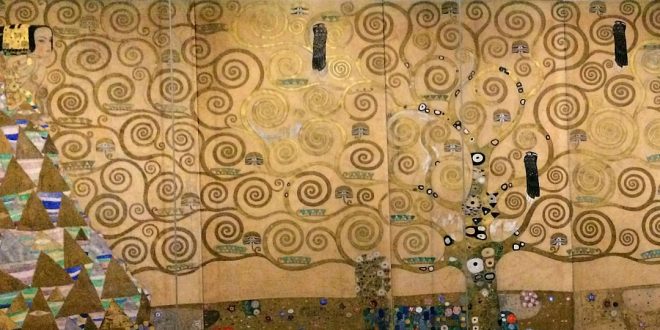Vienna Art. If you generally like art there is no better place than Wien. Not just because the city is packed with museums and artwork but because of its variety. In this post I’m going to focus on the most popular art periods in Wien, and where in town you can dive into them.
Baroque Period in Vienna
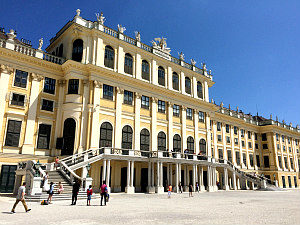 Vienna Art. Much of what you see in the city centre is not just 250 to 300 years old but glamorously decorated and presented in opulent style. Together with Schonbrunn Palace, our number one tourist attraction, baroque art largely defines Austria’s capital.
Vienna Art. Much of what you see in the city centre is not just 250 to 300 years old but glamorously decorated and presented in opulent style. Together with Schonbrunn Palace, our number one tourist attraction, baroque art largely defines Austria’s capital.
Essentially, the 18th century produced a vast number of baroque buildings in Wien: from churches and Imperial powerhouses to town palaces. After all, there was a lot of empty space to fill, following the last siege of the Turks in 1683. Also, since the Empire didn’t host many economic opportunities the well off residents invested their money in new property.
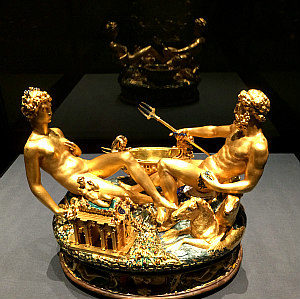 Where to see the best baroque art in Viennese museums? Definitely at THE Vienna Art Museum, aka Kunsthistorisches Museum because of its Italian baroque painters and Jan Brueghel master pieces. In addition, the museum’s Kunstkammer collects pieces of art and natural wonders, such as the famous Saliera, that celebrate baroque art.
Where to see the best baroque art in Viennese museums? Definitely at THE Vienna Art Museum, aka Kunsthistorisches Museum because of its Italian baroque painters and Jan Brueghel master pieces. In addition, the museum’s Kunstkammer collects pieces of art and natural wonders, such as the famous Saliera, that celebrate baroque art.
For real baroque fun there is no better place to visit than the Belvedere Vienna. Whereas mostly known for its Klimt paintings, the baroque palace of Prince Eugene of Savoy not just displays religious baroque tables. Instead, head for the hilarious character heads of Franz Xaver Messerschmidt. Displaying grimaces from rage and disgust to fear and fun, you can’t help making the same faces alongside them!
Find out in Baroque Period in Vienna which key pieces of baroque architecture, baroque gardens, baroque costumes and music you should see and experience.
Wiener Biedermeier
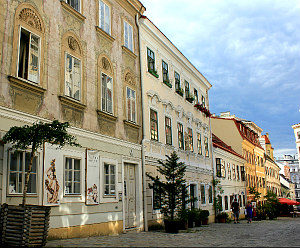 Vienna Art. Although you can find Biedermeier art in Germany, too, Wien holds the key to the most charming paintings, houses, furniture and fashion. Biedermeier defines the dominant art form between the end of the Congress of Vienna and the Revolution in 1848. Since State power resurged citizens withdrew into a romantic world inside their own homes.
Vienna Art. Although you can find Biedermeier art in Germany, too, Wien holds the key to the most charming paintings, houses, furniture and fashion. Biedermeier defines the dominant art form between the end of the Congress of Vienna and the Revolution in 1848. Since State power resurged citizens withdrew into a romantic world inside their own homes.
Hence, if you like elegant design, great craftsmanship and romantic patterns include Biedermeier art into your itinerary. On top, you will get a perfect glimpse into bourgeois Viennese life of the 19th century.
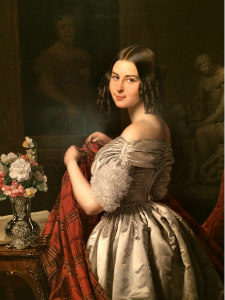 To soak up Biedermeier atmosphere there is no better place in Vienna than the Spittelberg quarter. If you follow my Art Walk route you’ll get to see rows of original Biedermeier houses and courtyards. To find the best Biedermeier paintings head for the Austrian National Gallery at Belvedere Vienna and to Wien Museum (Vienna Museum). The painting on the right shows ‘A Young Woman At Her Toilette’ (1840) by famous Biedermeier painter Ferdinand Georg Waldmuller (Wien Museum). The latter also exhibits some elegant original Biedermeier dresses.
To soak up Biedermeier atmosphere there is no better place in Vienna than the Spittelberg quarter. If you follow my Art Walk route you’ll get to see rows of original Biedermeier houses and courtyards. To find the best Biedermeier paintings head for the Austrian National Gallery at Belvedere Vienna and to Wien Museum (Vienna Museum). The painting on the right shows ‘A Young Woman At Her Toilette’ (1840) by famous Biedermeier painter Ferdinand Georg Waldmuller (Wien Museum). The latter also exhibits some elegant original Biedermeier dresses.
Since Biedermeier art is so popular with historic furniture make sure you see the fully furnished Biedermeier rooms at the Hapsburgs Museum of Furniture. Another Biedermeier favourite of mine is the collection of chairs and other furniture at the Museum of Applied Arts / Contemporary Art (MAK).
Fin De Siècle Vienna And Modernism
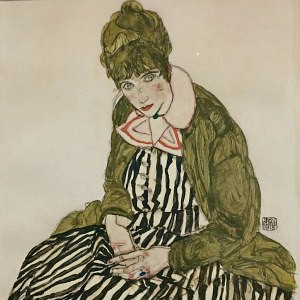 Vienna Art. About 100 years ago, Vienna sent shockwaves through the art world. Controversial artists such as Egon Schiele and Adolf Loos produced scandals that raged across local magistrates, coffeehouses, hairdressing salons and established art circles. Architect and designer Otto Wagner and painter Gustav Klimt evolved gradually from artists of the establishment to groundbreaking pioneers of a revolutionary art form.
Vienna Art. About 100 years ago, Vienna sent shockwaves through the art world. Controversial artists such as Egon Schiele and Adolf Loos produced scandals that raged across local magistrates, coffeehouses, hairdressing salons and established art circles. Architect and designer Otto Wagner and painter Gustav Klimt evolved gradually from artists of the establishment to groundbreaking pioneers of a revolutionary art form.
The architectural centrepiece of Vienna Modernism was and still is the Vienna Secession. Today, no one bats an eyelash when seeing it. But it was built at the end of the 19th century, the white cubes balancing a huge golden sphere split the local art world. Get my top Fin de Siecle Vienna travel tips.
Otto Wagner In Vienna
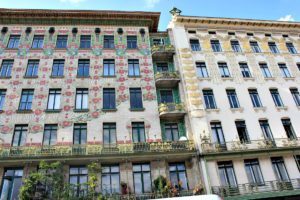 Vienna Art. Ornaments, swirls, flowers, and elegant minimalism. Austria’s capital collects the best Art Nouveau architecture in Europe. If you want to experience Wiener Jugendstil and Wiener Moderne follow one man: Otto Wagner.
Vienna Art. Ornaments, swirls, flowers, and elegant minimalism. Austria’s capital collects the best Art Nouveau architecture in Europe. If you want to experience Wiener Jugendstil and Wiener Moderne follow one man: Otto Wagner.
The Austrian architect and designer created signature pieces. The Majolikahaus, the Austrian Postal Savings Bank, and the pavilions on Karlsplatz are just a few. They build a stark contrast to Vienna’s baroque architecture. You can find most of them in the city centre. Access my 10 key tips on Otto Wagner in Vienna to see in town.
Gustav Klimt Artwork
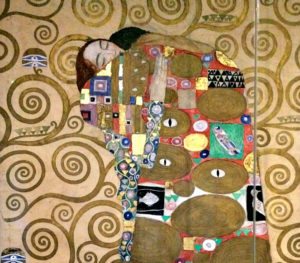 Vienna Art. Without doubt Gustav Klimt is Vienna’s most popular artist. His exuberant ornaments and delicate female portraits were both innovative and provocative. In fact, to fully understand Vienna 1900 you need to get behind the symbolisms of his paintings.
Vienna Art. Without doubt Gustav Klimt is Vienna’s most popular artist. His exuberant ornaments and delicate female portraits were both innovative and provocative. In fact, to fully understand Vienna 1900 you need to get behind the symbolisms of his paintings.
Therefore, before you visit Vienna get familiar with key Klimt masterpieces, and find out where to find them. My guide to Gustav Klimt artwork will help you.
Klimt Villa
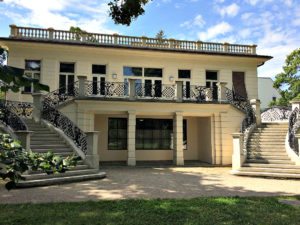 Vienna Art. If you love Gustav Klimt’s work seeing his output may not be enough. At the Klimt Villa close to Schönbrunn Palace you’ll not only walk into Klimt’s last studio but will gain a better insight into what inspired the Art Nouveau artist. In fact, the place is filled with not just art, but quotes from friends and promoters, personal photographs and original furniture.
Vienna Art. If you love Gustav Klimt’s work seeing his output may not be enough. At the Klimt Villa close to Schönbrunn Palace you’ll not only walk into Klimt’s last studio but will gain a better insight into what inspired the Art Nouveau artist. In fact, the place is filled with not just art, but quotes from friends and promoters, personal photographs and original furniture.
Before you visit the site it is important to know what you can expect. I was there in the summer of 2016. Read my review about the Klimt Villa.
Adolf Loos Vienna
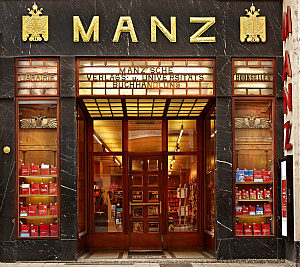 Vienna Art. At the same time when Art Nouveau displayed splendid ornaments and playful decorations Adolf Loos promoted a modernist view of the world. Unsurprisingly, the architect and cultural critic ignited both fierce criticism and admiration by local society.
Vienna Art. At the same time when Art Nouveau displayed splendid ornaments and playful decorations Adolf Loos promoted a modernist view of the world. Unsurprisingly, the architect and cultural critic ignited both fierce criticism and admiration by local society.
While he was first sympathising with the Vienna Secession Loos soon turned into their fiercest critic. For example, he detested Josef Hoffmann, while absolutely respected Otto Wagner.
During my research about Adolf Loos for my post I read his famous Ornament und Verbrechen (Ornament and Crime), which is also available in English. Definitely a great read for aesthetics fans and modernists! Learn more about Loos and his top 10 Modernist design to visit in Adolf Loos Vienna.
Street Art In Vienna
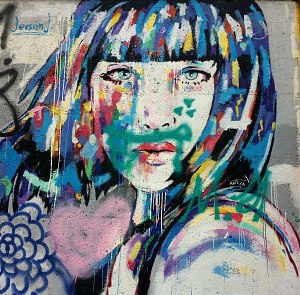 Just outside the confines of the historic center you can open up pockets of weird and wonderful sreet art. Because the municipality has freed up a lot of surfaces outside the center to legal graffiti, and tolerates a little more, street art is flourishing in Wien. Probably the most talked about is the graffiti art along the Danube Canal. There, along a good mile on both sides, tags and simple throwups mix with elaborate designs such as a diver and the split-in-half portrait of Sigmund Freud by internationally renown Austrian artist Nychos.
Just outside the confines of the historic center you can open up pockets of weird and wonderful sreet art. Because the municipality has freed up a lot of surfaces outside the center to legal graffiti, and tolerates a little more, street art is flourishing in Wien. Probably the most talked about is the graffiti art along the Danube Canal. There, along a good mile on both sides, tags and simple throwups mix with elaborate designs such as a diver and the split-in-half portrait of Sigmund Freud by internationally renown Austrian artist Nychos.
Actually, my favorite street art patch in Vienna is boho district Mariahilf. Located alongside Naschmarkt the area around Gumpendorfer Strasse and Mariahilfer Strasse displays dozens of amazing street art, most of it inspiring and haunting portraits. The photo on the right of the girl’s head is from a quiet side street close to Gumpendorfer Strasse. Since street art is so prolific and expressive there street art walking tours have been flourishing in the past few years.
which Vienna Museums to Visit
visit Vienna Tourism Tips
back to Vienna Unwrapped homepage
